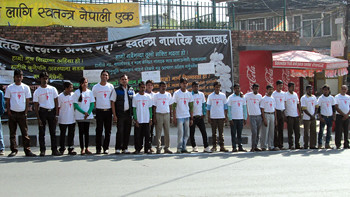
STATELESS IN MOTHERLAND: 21 Madhesis from five Tarai districts who are without citizenship cards staged a silent protest in front of the PM’s residence in Baluwatar in March.
Raju Ahmed of Bhandara, Chitwan once asked a question to undersecretary of Home Ministry Bishnu Poudel that lef him speechless: “I have a voter’s ID card from last elections, so how am I not eligible this time?” Months later, Ahmed is still caught up in the citizenship battle with the state. His chance of getting a citizenship by descent passed way with his father’s death and acquiring a citizenship through his mother is next to impossible given the bureaucratic red tape.
The importance of citizenship cards have grown ever since the new rule for voters’ registration came into effect. Citizenship cards are now required for voter registration which means millions of Nepalis like Ahmed won’t be able to exercise their right to vote in the upcoming elections.
A study conducted by the Forum for Women Law and Development (FWLD) shows that as of July 2011 there are over 4.3 million Nepalis of eligible age who are without citizenship cards. As of l July 2011, 34 per cent from the mountainous region, 28.5 per cent from the hills, and 17.5 per cent from the Tarai don’t have citizenship according to the study.
Ever since the state started distributing citizenship cards a large chunk of the population has always been left behind. Between 1952 and 1986, over 2.8 million citizenship cards were distributed while eight million citizenship cards were distributed from 1989 to 1990.
In 1994, a nine member high level committee headed by MP Dhanpati Prajapti was formed to study contentious issues related with citizenship. The study revealed that out of 11.3 million people over the age of 16 only 8.8 million had citizenship certificate. In 2007, the government task force distributed 2.6 million citizenship cards in the rural areas.
A similar study by Patan Campus in 2006, found that more than 800,000 Nepalis who were 16 years and older were without citizenship certificates. The study was based on the 2001 census, which found that the population of people over the age of sixteen was more than 13.2 million.
A study conducted by the National Dalit Commission in 2004, estimated that 33 per cent people from the Dalit community did not have citizenship certificates. Among 39,660 members of the Dalit community aged 16 and above surveyed in the study, it was found that 14,056 were stateless.
The Election Commission of Nepal estimates that over two million individuals aged 16 and above do not have citizenship certificates as of 19 August 2011. The largest number of people without citizenship cards reside in Manang with 43 per cent followed by 42.5 per cent in Humla, 41 per cent in Mugu, 14 per cent in Dailekh, 11 per cent in Saptari and nearly two in Kanchanpur.
Executive Director of FWLD and advocate Sabin Shrestha says that the government needs to make quick changes to the laws so that the millions of stateless people living within the borders of Nepal can get their basic rights to citizenship and become eligible to vote in the next elections.